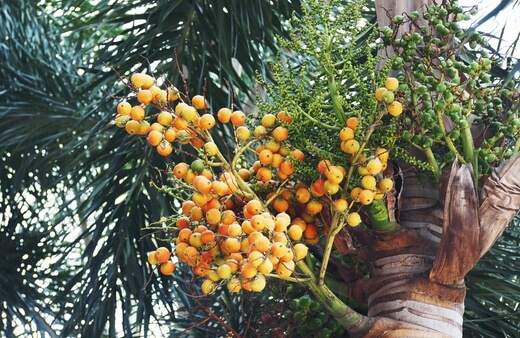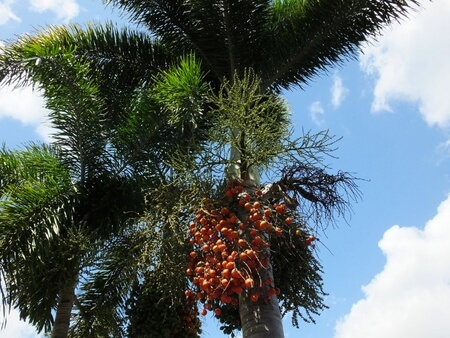The Foxtail Palm with its bushy leaves is certainly one of my favourites, but I do love all palm trees in general. They make me feel like any time is cocktail time, and that long hours of sunshine are not far away. This particular palm is an Australian gem all our own.
In our how to grow and care guide, I’ll chat through a brief introduction to the tree, and then move on to how to propagate and care for your own Foxtail Palm.
More...
Family: | Arecaceae |
|---|---|
Genus: | Wodyetia |
Species: | W. bifurcata |
Common Names: | Foxtail Palm |
Location: | Outdoor |
Type: | Tree |
Growth: | Up to 9 metres tall and 3 metres wide |
Sun requirements: | Full sun |
Foliage Colour: | Blue, green |
Flower Colour: | White |
Flowering: | Spring |
Fruit: | Olive green to orange-red |
Maintenance level: | Low |
Poisonous for pets: | No |
Introducing the Foxtail Palm

The tropical Foxtail palm hails from a tiny part of Australia – the Cape Melville National Park. These palms were particularly living on the boulder and gravel covered hills of the Cape Melville range. The palm produces white flowers and the leaves are a whole variety of shades of green.
The shape of the leaves look a bit like a fox’s tail, hence the Australian name of Foxtail palm. Aside from attractive leaves and flowers, the palm produces fruit that is an olive green colour when it’s young and turns an orange red colour when it becomes ripe.
Wodyetia bifurcata Plant Features
Much like the king palm, the Foxtail palmalso has a long and thin trunk which cleans itself. This palm tree can reach a height of 9 metres and the colour of the trunk is made up of rings of dark and light grey and becomes white over time.
This Australian gem, once the world got to know about it, was known for seeds that were considered incredibly valuable. People were so desperate to get their hands on the seeds that there was even a black market for them. The Foxtail palm is now known the world over and certainly considered a very popular choice.
How to Grow Foxtail Palm
Sunlight Needs
Your Foxtail palmis going to need to live somewhere that has full sun. Like any sun worshipper trying to catch a decent tan, you’re aiming for at least 6 hours of direct sun each day. You can opt for partial shade if necessary but the palm won’t grow as quickly.
Soil
Foxtail palms enjoy a well-draining and sandy soil. That means no soil where water is likely to just sit. If you are living in an area that has clay soil or where the soil might become waterlogged, rather create a mound for planting. This will help with drainage.

Watering Foxtail Palm
The Foxtail palm is a drought tolerant option for your garden. Once the tree is established, you don’t even need to water it and it will just keep going. Ideally if there is a drought, some water will help keep the palm looking good and growing at a decent rate. It usually takes about 2 years for the Foxtail palm to establish itself.
What Fertiliser to Use
The Foxtail palm can handle its salt so if you are growing a coastal garden, this is a good palm to choose. The secret to keeping the palm leaves looking green and lush is fertiliser. You can apply this in the springtime.
The fertiliser you choose should be generous with the amount of nitrogen – this is the ingredient that creates those gorgeous green leaves. A controlled release fertiliser would be best. This allows enough time to really get to the root system which is quite spread out.
Our gardening tips section has a category dedicated to all things fertiliser related, from the best compost bins to buying guides.
Mulching
Here’s another tip for ultimate nutrition for your Foxtail Palm – you can add a layer of mulch over the soil when you plant the tree. Mulch is a gardener’s friend that works to keep moisture in the soil. This is hugely beneficial to keep weeds away. Just a reminder that you don’t want the mulch to touch the tree trunk.
Pruning Foxtail Palm
Your Foxtail palm is super low maintenance. The self-cleaning tree doesn’t need any pruning – it just gets rid of dead leaves, dropping them off the tree, and the new growth will follow.


Get Your Free Guide:
Master Growing Australian Natives eBook
A Must Have Complete Guide for Every Australian Garden
Get Your Free Guide:
Master Growing Australian Natives eBook
A Must Have Complete Guide for Every Australian Garden
How to Propagate Foxtail Palm
The best way to propagate your own Foxtail palm is from seed. Ideally if you can, you can pick seeds and plant them while still fresh. The seeds of this palm look like small tomatoes and each fruit has one seed in it.
The perfect time for picking the seeds is when they are actually over ripe. This gives the best chance for germination. You can start off by soaking the seeds in warm water for around 72 hours.
This helps to loosen the pulp. It’s a good idea to change to fresh water each day. Any seeds that float to the top of the water can be thrown away. The ones that sink to the bottom of the container are the winners. After soaking is complete, you can rinse your seeds to get rid of any pulp left behind.
Next, you are going to dip your seeds in a bleach and water solution – one part bleach to ten parts water. Rinse the seeds afterwards. You’re now going to scarify the seeds – in nature, the seeds are tossed around a bit when they fall from the tree and it roughens up the seed coat.
To scarify the seed is essentially doing what nature would usually do. You can do this with sand paper or even a nail file. You could also use a knife tip. Once you’ve followed these processes, your seeds will be ready and you want them fresh when they go into the garden directly or ready for indoor planting.

Planting Foxtail Palm in Containers
You can plant the seeds in a container with a sandy and well-draining potting mix that should be kept moist. You want to give enough space for the seedling to grow so aim for a pot that is between 15cm and 30cm in depth.
You can plant a few seeds together or just one, depending on how many you are wanting to grow. Place the seed on its side when you plant it. You can either leave the top of the seed sticking out of the mixture or cover the seeds with a sprinkling of potting mixture.
You can place the pot in a plastic bag to create a greenhouse effect for the seedling. Germination is a bit of a lengthy process, taking sometimes up to a year, but could also be between 1 and 3 months.
The potting mixture needs to be slightly moist at all times. Don’t stress if the seeds start to shrivel or look weary – this is absolutely normal. When your seeds have started sprouting, their pot will need to be placed somewhere warm and humid.
You can also mist the seedling to help with humidity. Placing the pot in a bathroom for example also achieves the optimum growing conditions. When the spring or summer time arrives and your seedling has around 4 sets of leaves, you’ll know it’s ready for transplanting.
Foxtail Palm Pests and Diseases to Look Out For
Crown rot and root rot
If your Foxtail palm has crown or root rot, you might notice that the leaves become brown or yellow. A wilting tree is also a sign, and if you notice that its growth has slowed down. Soft and mushy roots might be lurking below the soil.
The cause of this disease is usually over watering and soil that doesn’t drain well. If the weather has been cold and damp, this also can cause problems for your tree.
Leaf blight
This is a fungal disease and you’ll notice brown spots that are surrounded by yellow borders. You could give your tree a very thorough pruning to get rid of the leaves that are infected and could find a fungicide appropriate for leaf blight.
Brown spot
The Foxtail palm is a much-loved treat for various types of leaf spot funguses. If you’re dealing with brown spots, you might see circle spots or slightly stretched out ones. A copper based fungicide is quite effective for your tree.
When you water your tree, don’t wet it from above as this can kick start this disease. Giving a Foxtail palm enough ventilation is another important factor here.
Ganoderma butt rot
Ganoderma butt rot is a very serious fungus. It causes the tree to wither and old leaves to fall off. Any new growth on the tree is a very light green or a yellow colour and won’t look very healthy.
The trunk will develop dents on the surface closer to the soil. They look like white dots at first and then turn brown and can grow as big as 30 cm in size. There is no treatment for this disease and it can kill off a Foxtail palm in a matter of years.
You’ll need to remove it from the garden so the disease doesn’t spread to other plants and trees.
Potassium deficiency
If your Foxtail palm has a potassium deficiency, you would notice smallish orange and yellow spots on the old leaves and can spread to cover an entire palm frond. This condition won’t kill your tree which is good news.
Eventually new leaves will grow and replace the dead ones so just give it a bit of time. You can use potassium fertiliser to give your palm the nutrient boost that it needs.
Iron deficiency
Your Foxtail Palm might be suffering from an iron deficiency if the leaves start yellowing and then turning brown at the ends. It can happen if you overwater your tree and if it’s growing in a pot even more so.
You want to ensure the roots have enough ventilation. You can use a slow release iron based fertiliser to restore the balance that your tree needs.
Foxtail Palm Frequently Asked Questions

Is it possible to grow a Foxtail Palm indoors?
The Foxtail palm likes plenty of light, so growing them indoors might be a challenge unless you can get the lighting requirements right.
Where did the Foxtail Palm get its botanical name Wodyetia bifurcata?
The world didn’t even know about the fantastic Foxtail palm until 1978. It was discovered by an Aboriginal man, whose name was noted as Wodyeti. This led to the name of this particular genus.
The name bifurcata is Latin and it means divided into two parts. It describes the forked fibres on the seed.
How long can a Foxtail Palm live for?
The average life of a palm tree is around 80 years. Some only live for 40, and others can live up to 100 years.
The Alexander palm is another great choice for the Australian garden. Have a look at our in-depth Alexander palm growing guide here.
Feeling inspired and wanting to learn more about Australian native plants and other gardening advice? Sign up for our newsletter.
Grow Foxtail Palm to Add More Tropical Feel to Your Garden
Thinking about the Foxtail palm makes me feel proudly Australian. To think that this amazing specimen which was once hiding out in a national park, is now popular and loved the world over.
Just looking at this palm brings joy. If you’re inspired to grow your own from seed, you won’t regret it. The care is easy and you can think of it as a long term investment. I’m giving the Foxtail palm my green thumbs up.
Published on October 27, 2022 by Lorri Hopkins
Last Updated on January 25, 2025





I have both Alexander and Foxtail seedlings sprouting underneath and together – some seem to have little flowers at the base – are these foxtail ???
Hi Sharyn,
How large are the seedlings? Neither Alexander nor Foxtail palm trees should get flowers on at the seedling stage. Have you got any pictures for us to take a look at?
The seedlings usually have two elongated leaves, and new growth comes from the middle. They need to have developed a stalk of at least 4” and be around 1m tall before they should even get close to flowering. Did they self-seed naturally in the garden, or did you plant them?
If you can send pictures, I’ll try to give more specific advice.
Best regards,
Lorri Hopkins